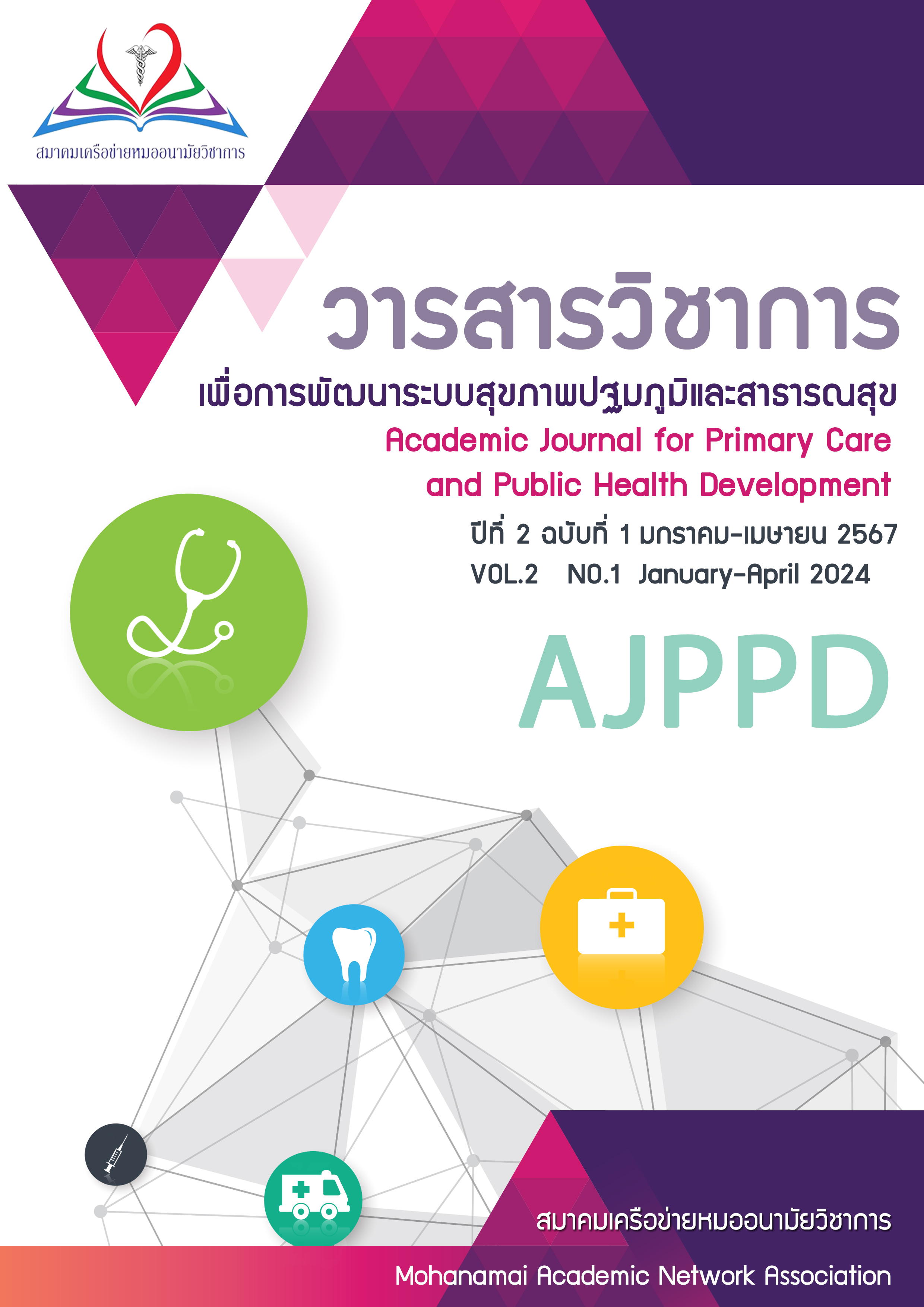The Relationship between the Perceptions of Health Belief Patterns and the Dengue Fever Prevention for People in Bang Tabun Subdistrict Health Promoting Hospital Area, Ban Laem District, Phetchaburi Province.
Keywords:
Health Belief Model, Preventive Behaviour, Hemorrhagic DiseaseAbstract
This cross-sectional survey research aims to study 1) perceptions of health beliefs, 2) behaviors to prevent dengue fever among citizens, and 3) the relationship between perceptions of health beliefs and the behaviors of those people to prevent dengue fever. The population of this study was 603 people, each representing their household and aged 18 years and over. The sample size was 148 people, recruited by a simple random sample. Data were collected through a questionnaire, which was used for the quality check. The IOC value is between 0.67 and 1.00, and the reliability value is 0.933. The data were analyzed using descriptive statistics and Spearman's correlation coefficient statistics.
The results found that the sample perceived preventive disease barriers (M=4.11, S.D. =0.43), perceived disease severity (M=4.04, S.D.=0.42), relationship factors (M=3.89, S.D.=0.35), perceived benefits of disease prevention (M=3.82, S.D.=0.43), and perceived risks of disease (M=3.80, S.D.=0.33) at a high level. While the health motivation (M=3.65, S.D.=0.41) and overall dengue prevention behavior are at a moderate level (M=3.40, S.D.=0.36). There was a positive direction regarding the relationship between perceptions and dengue fever prevention behavior. For example, health incentives had a moderate level (r=0.426, p < 0.01), relationship factors had a low level of correlation (r=0.317, p < 0.01), and perception of the benefits of disease prevention had a very low relationship (r=0.191,p=0.020)
From these results, the relevant agencies, including the Ministry of Public Health and the Subdistrict Administrative Organization, must provide adequate support for the people regarding materials and equipment to prevent disease. In addition, the involved personnel must have good relationships with them, which can help keep the public continually aware of dengue fever and up to date with the outbreak situation
References
กรมควบคุมโรค. (2561). แนวทางการเฝ้าระวังป้องกันควบคุมโรคไข้เลือดออกในเขตเมือง. กรุงเทพ ฯ: โรงพิมพ์ชุมชนสหกรณ์การเกษตรแห่งประเทศไทย จำกัด.
กรมควบคุมโรคติดต่อ. (2564). รายงานโรคไข้เลือดออก ปี 2564. นนทบุรี: กรมควบคุมโรค กระทรวงสาธารณสุข.
ชนิดา มัททวางกูร, ปรียานุช พลอยแก้ว, อโนทัย ถวัลย์เสรีวัฒนา, อำพร สิทธิจาด และธำรงเดชน้อยสิริวัฒนา. (2560). ปัจจัยที่มีความสัมพันธ์กับพฤติกรรมการป้องกันและควบคุมโรคไข้เลือดออกของประชาชนในพื้นที่รับผิดชอบของโรงพยาบาลส่งเสริมสุขภาพตำบลสายสี่ จังหวัดสมุทรสาคร. วารสารพยาบาลศาสตร์ มหาวิทยาลัยสยาม, 18(34): 34-48.
ธนกฤติ นุ้ยกูลวงศ์. (2558). พฤติกรรมการป้องกันไข้เลือดออกของประชาชน กรณีศึกษา: อำเภอสะเดา จังหวัดสงขลา. วิทยานิพนธ์สาธารณสุขศาสตรมหาบัณฑิต สาขาวิชาสาธารณสุขชุมชน, บัณฑิตวิทยาลัย มหาวิทยาลัยราชภัฎสงขลา
บุญประจักษ์ จันทร์วิน. (2565). ความสัมพันธ์ระหว่างการรับรู้กับพฤติกรรมป้องกันโรคไข้เลือดออกของประชาชนในอำภอที่มีอัตราป่วยสูง จังหวัดนครศรีธรรมราช. วารสารวิชาการสาธารณสุขชุมชน, 8(4), 141-156.
บุญประจักษ์ จันทร์วิน, นรานุช ขะระเขื่อน และวัลลภา ดิษสระ (2565). ปัจจัยทำนายพฤติกรรมป้องกันโรคไข้เลือดออกในอำเภอที่มีอัตราป่วยสูง จังหวัดนครศรีธรรมราช. วารสารเกื้อการรุณย์, 29(2), 204-217.
ปุญญพัฒน์ ไชยเมล์. (2556). การกำหนดขนาดตัวอย่างสำหรับการวิจัยเชิงพรรณนาในงานสาธารณสุข. วารสารมหาวิทยาลัยทักษิณ, 16(2): 9-18.
พุทธิพงศ์ บุญชู. (2563). ปัจจัยที่มีความสัมพันธ์กับพฤติกรรมการป้องกันและควบคุมโรคไข้เลือดออก: ศึกษาเปรียบเทียบหมู่บ้านปลอดโรค กับหมู่บ้านที่มีการระบาดของโรคในตำบลน้ำผุด อำเภอเมืองตรัง จังหวัดตรัง. วารสารสาธารณสุขและวิทยาศาสตร์สุขภาพ, 3(3), 79-94.
วีรพงษ์ ชมพูมิ่ง และสวัสดิ์ ดวงใจ. (2562). การรับรู้และพฤติกรรมการป้องกันโรคไข้เลือดออกของประชาชนในอำเภอสอง จังหวัดแพร่. วารสารวิชาการป้องกันควบคุมโรค สคร.2 พิษณุโลก, 6(3), 47-60.
สำนักงานสาธารณสุขจังหวัดเพชรบุรี. (2566). รายงานประจำปี 2566. กระทรวงสาธารณสุข
สำนักงานสาธารณสุขอำเภอบ้านแหลม. (2566). รายงานประจำปี 2566. สำนักงานสาธารณสุขจังหวัดเพชรบุรี: เพชรบุรี.
Bartz, A. E. (1999). Basic Statistical Concepts: Merrill.
Becker, M. H., & Maiman, L. A. (1974). The Health Belief Model: Origins and Correlation in Psychological Theory. Health Education Monography, 2. Winter: 336-385.
Best, J. W. (1977). Research in Education. (3nded). Englewood Cliffs: Prentice-Hall.

Downloads
Published
How to Cite
Issue
Section
License

This work is licensed under a Creative Commons Attribution-NonCommercial-NoDerivatives 4.0 International License.




